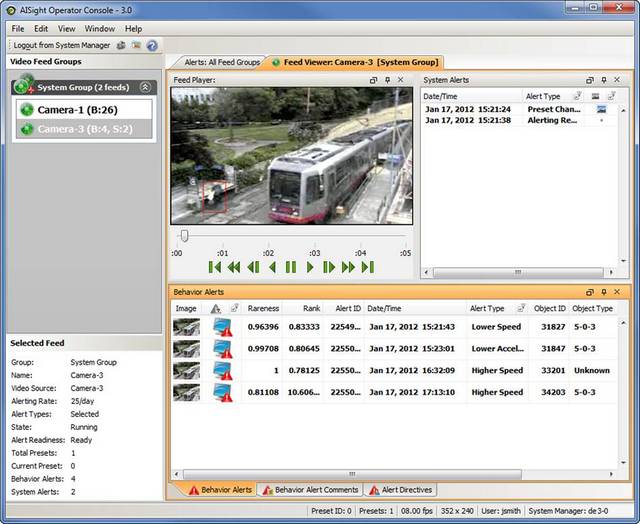A new breed of security cameras can supposedly detect terrorism and crime without a human judgment call--and mass transit agencies are shelling out big bucks for the product. San Francisco's Municipal Transit Authority, which oversees the city's MUNI trains, has signed a contract with security firm BRS Labs to deploy cameras to 12 subway stations that use algorithms and machine learning techniques to spot anomalous behavior.
BRS Labs is a security firm that provides behavior recognition software for video surveillance. The company's clients include government, tourist attractions, military bases, and private industry; BRS's software issues real-time text alerts when cameras detect strange behavior. Servers connected to security cameras observe locations for weeks at a time and then establish a baseline of “normal” behavior based on this timespan; anomalous activities afterwards (loitering, abandoned packages, abnormally high/low numbers of passengers) trigger an alert. No tripwires or programming of initial parameters are required.
According to a publicly available product bid, the San Francisco MUNI project will include up to 22 connected cameras at each train station; video monitoring will be conducted by train control, MUNI Metro East facility, and in-station personnel. The video systems will build memories of observed behavior patterns that mature with time; the systems, in the bid's words, “[have] the capability to learn from what [they] observe.”
In an interview with Fast Company, BRS Labs President John Frazzini said that the company's AIsight behavior recognition product relies on 11 patents related to computer vision technology and surveillance imagery. BRS's patents primarily deal with the intersection between computer vision and machine learning; video footage grabbed by MUNI cameras will be automatically translated into code for real-time processing. Clips of anomalous activity are dispatched to MUNI employees automatically; SMS text message alerts are also sent to staffers' mobile phones.

The post-9/11 emphasis on “homeland security” and anti-terrorism efforts has resulted in a gold rush of surveillance contracts from mass transit agencies and public institutions nationwide. While large mass transit agencies such as New York's MTA and Chicago's CTA have been cagey about their counter-terrorism efforts, trade show presentations and chatter in industry publications have given a basic idea of what is happening. Apart from machine learning-based video surveillance, subway security has also taken on wackier (and scarier) aspects: The Homeland Security Department has publicly announced their plans to release bacteria into Boston T tunnels this summer in order to test new biological weapon detectors deployed throughout the subway system.
The same technology that's being deployed in San Francisco's subway is also intended for the global market. BRS, which is based in Houston, has overseas offices in London, Sao Paulo, and Barcelona. BRS Labs' AISight product is primarily intended for use in counter-terrorism efforts. AISight's software algorithm has limited success in detecting in-station muggings or subway perverts, two issues of much more immediate interest to mass transit ridership than terrorist attacks.
Another unique aspect of BRS's product is the fact that it heavily relies on timestamps and time recognition. Behavior and objects are coded according to the times of day or days of the week in which they most frequently occur; the velocity, acceleration, and path of customers passing through a station are analyzed as well. Spatial anomalies and classification anomalies are taken into account as well.
One worrying--or appealing to budget-minded clients--aspect of BRS's product is the fact that their software product sharply reduces the need for human camera maintenance. The algorithms behind AISight compensate for lighting changes, shaky images, and poor bandwidth. Between the automated evaluation of “anomalies” and their software-based maintenance process, the need for human supervision for effective software operation sharply declines.
Fast Company
No comments:
Post a Comment